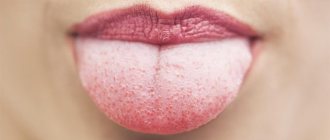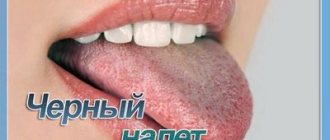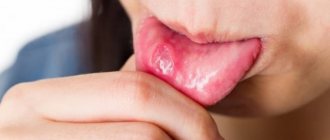Properties of plaque
In order to competently organize independent monitoring of the condition of the tongue to identify signs of incipient diseases on its surface, you need to know what factors and indicators you need to focus on.
Blue coating on the tongue - reasons
- The color has a fairly wide range of variations: transparent, white, yellowish, brown, gray. A red, green, crimson, or black tint may also appear. In children, it often turns out that the bright color was caused by a felt-tip pen that was in the mouth. It could be a caramel cockerel, a drink, or chewing gum. Therefore, before you panic, trying to understand why the child has a blue tongue, it is necessary to analyze the diet preceding this event. Adults experience color changes after drinking coffee, and smoking also contributes to this.
- There are several different types of plaque depending on the texture:
- dry;
- homogeneous;
- wet;
- oily;
- dense;
- loose.
- Sediment thickness is one of the key parameters. If upon visual examination it turns out that the plaque has increased in intensity and the pinkish lingual surface is practically not visible through it, control over the condition of the body should be strengthened. If the picture persists for 24 hours, it is advisable to apply for an appointment for examination.
- Localization of a spot of clearly defined deposits on a certain area of the tongue makes it possible to determine the location of the pathological focus in the body.
- The ease of removing plaque shows the degree of its pain. The normal translucent layer is peeled off during morning hygiene measures and does not appear throughout the day. Deposits that appear due to malfunctions in the functioning of specific systems are not completely removed, but after some time they become even thicker and acquire a color tone characteristic of the underlying disease.
The plaque in a healthy person is transparent and whitish in color. It does not block the view of the tissue of the tongue, is easy to clean, and has no odor. May be slightly yellowish in winter.
Tongue is a map of the body
In Tibet, China and India, the “Five Elements” theory has long existed, according to which doctors in these countries always begin examining a patient with the tongue. Using a mirror, you can do this yourself, paying attention to its color, shape and size, plaque, the presence of stars and wrinkles, whether it is wet or dry, dense or soft. Changes in the mucous membrane are very often not at all associated with diseases of the oral cavity.
Read also: Teeth rinses
Human language and projection of organ function
The zones on the surface of the tongue exactly repeat our body: the tip is the upper part of the body, and the root is the lower part. Depending on where changes appear on the mucosa, it is necessary to judge the nature of the disease.
You should also adhere to the following correspondence map:
- the tip of the tongue - the work of the lungs and heart system;
- middle (horizontal part) - pancreas and stomach, spleen, liver;
- root - responsible for the intestines;
- lateral areas - show kidney function;
- the middle (vertical part) is the spine.
A boy's blue tongue is the result of kidney disease
In a healthy person, the surface of the tongue is smooth and has a pale pink tone. Depending on the season, it may vary slightly. At the tip of a healthy organ you can see small papillae, in its central part there are larger ones, and at the root there is a huge accumulation of more massive papillae. They represent a variety of taste thermal and biochemical analyzers. It is these papillae that are connected to various organs of the human body.
Reasons for the formation of blue plaque
It is advisable to collect and analyze all cause-and-effect manifestations that allow us to solve the problem of why a person’s tongue is blue, in order to notice important signals in time. This shade may appear if there is trouble in the heart area. The localization of this color on the lower surface indicates circulatory disorders aggravated by cardiopulmonary failure.
What to do if a blue coating appears on the tongue
A bluish tint on the tongue appears with scurvy. It may also reflect insufficient blood circulation. For a specialist, this may be evidence of poisoning by mercury or other heavy metals. If a blue coating on the tongue suddenly appears on the edges of the tongue located in front of the pharynx, the reasons lie in the kidney area. This kind of indicator can warn of a serious illness. Blue-black spots disappear only after the functioning of the adrenal glands in producing hormones is normalized.
The bluish upper plane becomes an accurate sign of the onset of the development of cardiovascular failure without the presence of other symptoms such as pain, a feeling of oppressive heaviness, and weakness. This will allow you to carry out a set of preventive measures to prevent a heart attack.
What is cyanosis
Cyanosis, or blue discoloration of mucous membranes, is an alarming symptom that accompanies many dangerous diseases. It is not an independent disease, so the natural color returns only after the cause of its appearance is eliminated.
State Definition
With cyanosis, the dog's tongue, other mucous membranes and even the skin turn blue. Depending on the severity of the condition, the color varies from gray-blue to dark purple. Such changes occur when blood circulation is impaired and the level of oxygen in the blood decreases.
Varieties
According to the degree of distribution, cyanosis is divided into local and total. In the first case, only individual areas change color, and in the second, the entire body changes color.
Depending on the location, local cyanosis is divided into 2 more types:
- central, involving the mucous membranes of the oral cavity, the area around the eyes and nose;
- peripheral, changing the color of areas distant from the heart (paws, ears).
Based on the speed of development and severity of accompanying symptoms, acute and chronic cyanosis are distinguished. The first progresses quite quickly and can lead to sudden death. The second type develops very slowly, so for a long time, cyanosis may remain the only alarming symptom.
Types of plaque that appears on the tongue
The variety of plaques that appear on the lingual surface has its own explanation, based on their characteristic outlines, color shades, and localization.
- The entire tongue is covered with a dense whitish coating with a simultaneous increase in temperature - an infectious disease.
- White deposits appeared in the middle of the tongue with the simultaneous appearance of cracks on the sides - pathological changes in the intestines or stomach. At the first manifestations, it is advisable to follow an easily digestible diet without fatty and salty foods. If you feel pain, you should immediately undergo an examination and obtain medical advice.
- Deposits with a white tint in the anterior area are pathological manifestations in the respiratory system, one of the causes of which may be smoking.
- White spots of deposits all over the tongue are a fungal infection that occurs from the development of dysbacteriosis. Often a consequence of uncontrolled use of antibiotics.
- The presence of a spotted plaque of red and white color is an alarming signal, since the symptoms of scarlet fever often appear. Modern medicine has effective methods for curing this insidious disease; the main thing is to seek help in time.
- The yellowish tint of deposits in small quantities should not cause concern. But with their significant thickness and intensity, we can draw a conclusion about possible inflammatory foci of the gallbladder. If at the same time you begin to worry about pain on the right side under the ribs, you should be examined to diagnose cholecystitis.
- A gray tint of plaque indicates problems in the gastrointestinal system, including increased acidity due to malfunctions that lead to dehydration and disruption of the microflora.
- The transformation of plaque into a brown crust can warn of food poisoning. If there are few deposits, it is worth analyzing the diet to identify products that can color them brownish (chocolate, coffee, cocoa, strong tea). A non-disappearing plaque like this may indicate dysbacteriosis.
The black color of the deposits should alert you, as this may be a sign of the disease entering a critical phase.
Why does the tongue change color?
Normally, the human tongue should be light pink in color with a thin layer of light coating. A change in color indicates that there is some kind of malfunction in the body. Thanks to this ability of the tongue, it has become easier for doctors to diagnose a particular disease.
READ IN DETAIL: human tongue: the color of a healthy organ and the reasons for its change
What can the different colors of the tongue tell us? So:
- pale pink shade - a person is absolutely healthy,
- white means that the body has problems with the intestines or stomach, possible fungal infection, colds, ARVI or dehydration (the initial stage of the disease),
- gray warns of chronic gastrointestinal disease,
- blue tongue - may mean that there are serious kidney problems, cyanosis, anemia or rhomboid glossitis,
- yellow - indicates disturbances in the functioning of the gallbladder, gastrointestinal tract, serious liver disease; this color of the tongue most often occurs in people who smoke (we recommend reading: what does it mean if there is a yellow coating on the tongue?),
- light red - indicates the presence of an infection or inflammatory process in the body,
- raspberry means a decrease in hemoglobin levels,
- bright red - blood diseases, disorders of the cardiovascular system,
- burgundy - signals an acute infectious disease,
- blue or purple - indicates problems with the heart and lungs,
- green - exacerbation of disease of the stomach or duodenum, disruption of the gallbladder,
- dirty gray - signals an inflammatory process in the abdominal cavity,
- brown - serious problems with the digestive system,
- black - is a sign of dehydration, acidosis, pancreatic diseases.
If the tongue darkens over time, this indicates that the person’s condition is deteriorating. A colorless tongue occurs in those who suffer from vitamin deficiency, anemia, or have an unhealthy diet. Very dark indicates the presence of acute chronic diseases that need to be treated urgently.
Causes of plaque in a child
Daily examination of the internal lining of the oral cavity should become a mandatory procedure. A light thin whitish layer on the tongue that disappears after hygiene procedures or eating is normal. If the whiteness does not disappear during the day, and the layer of plaque thickens, it can be assumed that the baby has a common fungal infection, usually called thrush.
Why is there a blue coating on the tongue?
If this disease is not treated promptly, painful ulcers will develop, which will make the child worry and cry. Whitish rashes also appear during colds, disappearing after recovery. Indigestion and vomiting paralleled by a whitish coating should alert parents and prompt them to immediately obtain a qualified medical opinion, as this could be gastritis.
A child’s blue tongue requires special attention, one of the key indicators that can reflect a number of pathological problems in various important sectors of the body:
- respiratory system;
- heart (angina pectoris, arrhythmia);
- circulatory system;
- kidneys
Babies who cannot yet speak cannot express the discomfort that arises from incipient diseases, and parents do not always know how to correctly identify the child’s crying as a consequence of the pain experienced. Therefore, any signal should serve as the beginning of close observation and, if deviations are detected, immediate contact with doctors. Often, a blue tongue in an infant is associated with disorders of the nervous system, accompanied by convulsions and disruptions in the functioning of the cerebral circulation.
Possible complications
If the pathology is not detected in time and the baby lives for a long period with purple or blue color in the oral cavity, then there is a possibility of causing various complications:
- Development of heart failure;
- Problems with the respiratory system;
- Improper kidney function;
- Metabolic disorders;
- Malocclusion, which leads to the inability of the baby to close the teeth when talking or eating food;
- Problematic pronunciation of words;
- Teeth move in different directions.
At the same time, a small person may develop an inferiority complex and mental discord due to the abnormal appearance of the oral cavity.
Thus, the appearance of a bluish tint indicates health problems. To prevent such complications, you need to monitor your own child’s condition and consult a doctor in time to prescribe treatment.
Ways to cleanse your tongue
To clean the surface of the tongue from the plaque that forms, it is not necessary to use complex techniques. Regular, affordable devices will do.
- The toothbrush may not have a special rough lining on the inside, oriented to directly carry out a thorough cleansing of thin normal deposits while simultaneously massaging the tongue. It is enough to walk with medium soft bristles with or without antibacterial paste in the direction from the root to the lips, as well as across the tongue to grab the side surfaces.
- You can purchase a special scraper. It is usually made of plastic, although metal or wood products are also available. Some scrapers are supplemented with special brushes.
If necessary, use reasonably accessible devices, for example, a teaspoon. You can take a bandage, wrap it around your finger, or use a clean towel or textile napkin.
Tongue hygiene is carried out only after teeth have been brushed. The movements of the scraper are directed only from the root of the tongue to its tip. First, the side with the brush is used, and then massage procedures are performed with the hard part of the device.
Blue coating on the tongue - reasons
Blue coating on the tongue
What to do if a coating appears on the tongue
Blue surface on the tongue What to do if a blue coating appears on the tongue
Dark coating on the tongue Why is there a blue coating on the tongue
Once again about attention to language
Based on the above, it should be noted that the color of the tongue is a kind of beacon for every person. Therefore, it should be given close attention, especially to the mucous membranes in children. Doctors recommend examining it daily for changes, especially in color. Various types of blue discoloration on it indicate a serious malfunction in the body system.
It should be noted that the tongue will show signs of illness approximately 1–2 days before the body organs themselves begin to ache.
Be healthy!
What to do if your dog's tongue turns blue
If your dog's tongue falls out and turns blue, contact the nearest 24-hour veterinary clinic. In acute cases, minutes count. If the attack occurred at night, do not delay the examination until the morning. This could cost your pet his life.
First aid
Before visiting the veterinarian, the owner can only alleviate the condition of his pet. If your dog has difficulty breathing, follow these steps:
- Place the dog on its side and prevent it from moving.
- Open all windows in your room or car to replenish your oxygen levels.
- Be sure to clear the mouth and nose of accumulated secretions.
- On the way to the veterinary clinic, do not forget to calm the animal with strokes and gentle words.
Try to keep your emotions under control so as not to worry your four-legged dog, and do not use medications without prescription. They can aggravate the condition and cause complications.
Treatment of cardiovascular diseases
Depending on the diagnosis, the following medications may be required for treatment:
- ACE inhibitors, which lower blood pressure;
- diuretics, removing excess fluid;
- antitussives;
- cardiotonics that increase the force of heart contraction;
- vasopressors, constrictors of blood vessels;
- antibiotics that fight concomitant infections;
- glucocorticosteroids used in antishock therapy;
- immunomodulators that stimulate the body's protective function.
Additional recommendations include reviewing your diet and reducing your usual exercise routine. Usual portions are reduced to avoid obesity, and salt, which causes swelling, is removed from food.
Treatment of respiratory diseases
If the condition is severe, oxygen therapy and fluid pumping may be required. After feeling better, they move on to eliminating the root cause and accompanying symptoms. For this, the following drugs are prescribed:
- diuretics;
- bronchodilators that relieve spasms in the bronchi;
- sedatives that reduce anxiety;
- antibiotics;
- vasodilators, dilating blood vessels;
- glucocorticosteroids that suppress allergic reactions;
- respiratory stimulants that normalize heartbeat.
Until the animal’s condition stabilizes, the animal is left in the hospital on infusion therapy. All this time, doctors are keeping an eye on him, who can quickly help if a new attack occurs.











